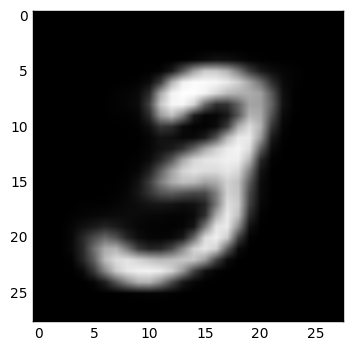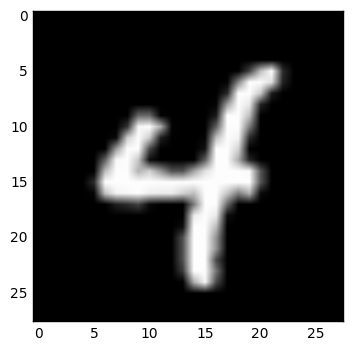Tensorflow implementation of Restricted Boltzmann Machine for layerwise pretraining of deep autoencoders.
This is a fork of https://github.com/Cospel/rbm-ae-tf with some corrections and improvements:
Bernoulli-Bernoulli RBM is good for Bernoulli-distributed binary input data. MNIST, for example.
Load data and train RBM:
import numpy as np
import matplotlib.pyplot as plt
from tfrbm import BBRBM, GBRBM
from tensorflow.examples.tutorials.mnist import input_data
mnist = input_data.read_data_sets('MNIST_data/', one_hot=True)
mnist_images = mnist.train.images
bbrbm = BBRBM(n_visible=784, n_hidden=64, learning_rate=0.01, momentum=0.95, use_tqdm=True)
errs = bbrbm.fit(mnist_images, n_epoches=30, batch_size=10)
plt.plot(errs)
plt.show()
Output:
Epoch: 0: 100%|##########| 5500/5500 [00:07<00:00, 743.34it/s]
Train error: 0.1268
Epoch: 1: 100%|##########| 5500/5500 [00:07<00:00, 760.61it/s]
Train error: 0.0847
Epoch: 2: 100%|##########| 5500/5500 [00:07<00:00, 763.98it/s]
Train error: 0.0770
Epoch: 3: 100%|##########| 5500/5500 [00:07<00:00, 767.36it/s]
Train error: 0.0706
Epoch: 4: 100%|##########| 5500/5500 [00:07<00:00, 720.42it/s]
Train error: 0.0645
Epoch: 5: 100%|##########| 5500/5500 [00:07<00:00, 741.36it/s]
Train error: 0.0594
Epoch: 6: 100%|##########| 5500/5500 [00:07<00:00, 739.19it/s]
Train error: 0.0556
Epoch: 7: 100%|##########| 5500/5500 [00:08<00:00, 686.20it/s]
Train error: 0.0527
Epoch: 8: 100%|##########| 5500/5500 [00:09<00:00, 582.32it/s]
Train error: 0.0504
Epoch: 9: 100%|##########| 5500/5500 [00:10<00:00, 549.63it/s]
Train error: 0.0485
...

Examine some reconstructed data:
IMAGE = 1
def show_digit(x):
plt.imshow(x.reshape((28, 28)), cmap=plt.cm.gray)
plt.show()
image = mnist_images[IMAGE]
image_rec = bbrbm.reconstruct(image.reshape(1,-1))
show_digit(image)
show_digit(image_rec)
Examples:





rbm = BBRBM(n_visible, n_hidden, learning_rate=0.01, momentum=0.95, err_function='mse', use_tqdm=False)
or
rbm = GBRBM(n_visible, n_hidden, learning_rate=0.01, momentum=0.95, err_function='mse', use_tqdm=False, sample_visible=False, sigma=1)
Initialization.
n_visible — number of neurons on visible layern_hidden — number of neurons on hidden layeruse_tqdm — use tqdm package for progress indication or noterr_function — error function (it's not used in training process, just in get_err function), should be mse or cosine
Only for GBRBM:
sample_visible — sample reconstructed data with Gaussian distribution (with reconstructed value as a mean and a sigma parameter as deviation) or not (if not, every gaussoid will be projected into a single point)sigma — standard deviation of the input dataAdvices:
0 to 1.0 mean and sigma standard deviation. If it's not, just normalize it.rbm.fit(data_x, n_epoches=10, batch_size=10, shuffle=True, verbose=True)
Fit the model.
data_x — data of shape (n_data, n_visible)
n_epoches — number of epochesbatch_size — batch size, should be as small as possibleshuffle — shuffle data or notverbose — output to stdoutReturns errors array.
rbm.partial_fit(batch_x)
Fit the model on one batch.
rbm.reconstruct(batch_x)
Reconstruct data. Input and output shapes are (n_data, n_visible).
rbm.transform(batch_x)
Transform data. Input shape is (n_data, n_visible), output shape is (n_data, n_hidden).
rbm.transform_inv(batch_y)
Inverse transform data. Input shape is (n_data, n_hidden), output shape is (n_data, n_visible).
rbm.get_err(batch_x)
Returns error on batch.
rbm.get_weights()
Get RBM's weights as a numpy arrays. Returns (W, Bv, Bh) where W is weights matrix of shape (n_visible, n_hidden), Bv is visible layer bias of shape (n_visible,) and Bh is hidden layer bias of shape (n_hidden,).
Note: when initializing deep network layer with this weights, use W as weights, Bh as bias and just ignore the Bv.
rbm.set_weights(w, visible_bias, hidden_bias)
Set RBM's weights as numpy arrays.
rbm.save_weights(filename, name)
Save RBM's weights to filename file with unique name prefix.
rbm.load_weights(filename, name)
Loads RBM's weights from filename file with unique name prefix.
Tensorflow implementation of Restricted Boltzman Machine and Autoencoder for layerwise pretraining of Deep Autoencoders with RBM. Idea is to first create RBMs for pretraining weights for autoencoder. Then weigts for autoencoder are loaded and autoencoder is trained again. In this implementation you can also use tied weights for autoencoder(that means that encoding and decoding layers have same transposed weights!).
I was inspired with these implementations but I need to refactor them and improve them. I tried to use also similar api as it is in tensorflow/models:
Thank you for your gists!
More about pretraining of weights in this paper:
Feel free to make updates, repairs. You can enhance implementation with some tips from:
此处可能存在不合适展示的内容,页面不予展示。您可通过相关编辑功能自查并修改。
如您确认内容无涉及 不当用语 / 纯广告导流 / 暴力 / 低俗色情 / 侵权 / 盗版 / 虚假 / 无价值内容或违法国家有关法律法规的内容,可点击提交进行申诉,我们将尽快为您处理。